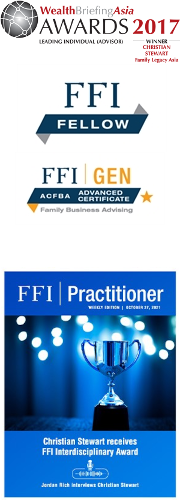Models Frameworks and Tools
When we work with families, we use a number of recognized Models, Frameworks and Tools to help them to organize and to plan strategically for the long term preservation of their family wealth. Objective Models Frameworks and Tools can help to provide an impartial way of looking at what can otherwise sometimes be emotionally charged issues. The right Framework can help a family to focus on the "big picture".One simple way to help a family think about its succession planning and governance issues is to consider the following four categories of (i) the family business, (ii) the financial wealth of the family, (iii) the family charity or foundation, and (iv) the "family enterprise". Each of these four categories needs separate planning as to (a) mission, (b) governance, (c) ownership and (d) succession.
The Family Meeting & The Family CouncilThe most basic but essential planning tool for a family is to conduct regular Family Meetings that are separate and distinct from business management meetings and board meetings.
|
The Four Dimensions Of Family Wealth
The wealth of a family can be viewed as comprising of its Human Capital, Intellectual Capital, Social Capital and Financial Capital (Hughes). The most important of these four components is the Human Capital. This framework helps the family to think about how to preserve and grow all aspects of its family wealth, not just the Financial Capital.
Values Based Estate PlanningIn this age of affluence it is critical to find ways to articulate and pass on the family values along with the money (Fithian). There needs to be a structured process to help identify family goals, objectives and values, which must then be incorporated into the planning and the governance documents.
|
The Three Circle Model
One important model for working with business owning families is the Three Circle Model (Tagiuri and Davis) which tells you that a family owned business is made up of three overlapping systems being the family system, the ownership system and the business system. Critical tasks include creating boundaries between these three circles, clarifying the roles and responsibilities of each circle, and creating appropriate forums.
The Life Cycle Of The Family BusinessAnother very important model which is a long term planning tool is to use a life cycles framework and to look at the transition events that a family business will be facing. For example, is the family business (i) owner managed, (ii) a sibling partnership, (iii) a cousin consortium or (iv) a family syndicate? (Carlock and Ward)
Family Policies To Help Manage ConflictMany conflicts within a family owned business can be explained in terms of a conflict between the interests of family members who are "on the inside" versus those who are "on the outside". The task is to manage the predictable differences that will arise as the interests of ownership and management of the family company start to diverge. The solution is the preparation of various written Family Policies. |


